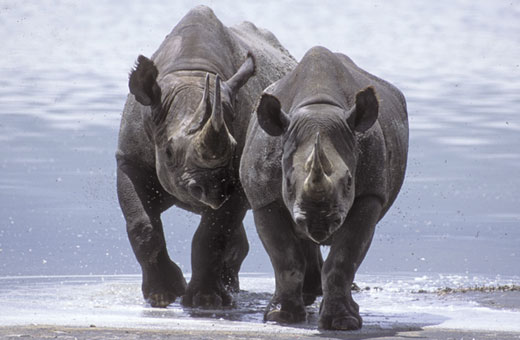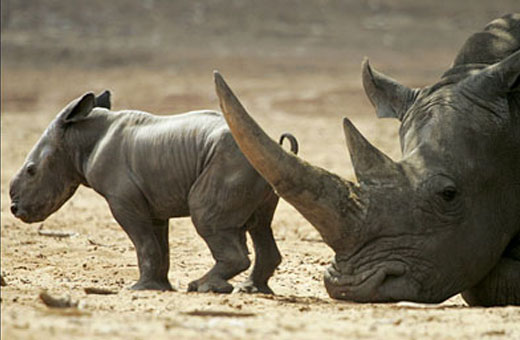Black Rhinoceros
The Black Rhinoceros draws its name not from its color but from its upper lip which is used to expertly grasp plant life for consumption. Sadly it is estimated that there are only around 3,600 of these magnificent rhinos life in the world today and because of this they are considered critically endangered. Another victim of humans the Black Rhinoceros has been poached relentlessly over the years for its horns and has earned more persecution because of its reputation for being very territorial and aggressive to humans.
The Black Rhinoceros are found only in southern Africa and conservation is under way to protect the Black Rhinoceros with a great number of the Black Rhinoceros being held in conservation areas across Zimbabwe, Kenya and Namibia.

Black Rhinoceros grazing
The favorite habitat of the Black Rhinoceros is the borderland between open plains and woodland but the Black Rhinoceros can also be found in a variety of habitats ranging from savannas, open grassland and shrub lands. Although these habitats are varied the Black Rhinoceros will not be found more than 25km from a substantial source of water.
Contrary to the name the Black Rhinoceros is actually of gray of yellow/brown coloration. The Black Rhinoceros can be recognized mainly by its distinct upper lip which is almost hook shaped and was actually given the name Black Rhinoceros to avoid confusion with the local White Rhinoceros. The dual horns of the Black Rhinoceros can grow over 50cm in length providing a formidable defense.

Female Black Rhinoceros grazing together
Like the Sumatran Rhinoceros the Black Rhinoceros frequents salt licks and will feed on most types of plant life including leaves and twigs. The Black Rhinoceros is for the most part a quite solitary animal who spends its days keeping cool in muddy water, however the Black Rhinoceros have been known to congregate in groups around a local salt lick.

A newborn Black Rhinoceros calf
Although most Black Rhinoceros prefer to find food by themselves usually in the twilight periods – the female of the species have been known to be more social often moving and feeds together in groups. The Black Rhinoceros can live up to 50 years and reach sexual maturity around the age of 6, after giving birth at around 6 or 7 years of age the female will produce usually 1 offspring around every 2 – 5 years.



This article is not completely right about the black rhino’s name. Its “black” name was picked simply to make a distinction between this rhino and the “white” rhino, that received its “white” name after the english explorers heard the locals call it “wit” (a word that sounded a bit like “white” but which actually meant “wide” or “large”).
Also, the rhinoceros in the last picture (the one with the newborn) are not black rhinos. They are South-type white rhinoceros.